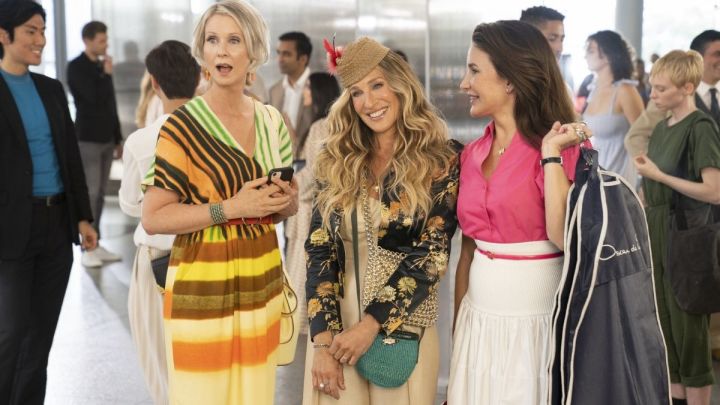Sex and the City is a landmark of American television. Debuting in the summer of 1998, the show revolutionized the comedic landscape of the new millennium, providing a refreshing and unashamed look into the sexual lives and desires of four women in their early thirties. Sex and the City broke boundaries and challenged expectations, cementing its network, HBO, as the home for groundbreaking and prestigious stories.
The show went on for six seasons, attracting mostly positive reviews from critics and audiences throughout most of its run. Anchored by a chaotic but irresistible performance from Sarah Jessica Parker, Sex and the City quickly became a phenomenon. The word “iconic” is used freely and carelessly these days, but in SatC‘s case, it’s genuinely fitting. The series challenged the audience’s perceptions, daring them to take a closer look at subjects previously considered taboo. The women of Sex and the City were bold and open about their sexuality; even prudish Charlotte was considerably more risqué than the typical leading lady of primetime television.
A tumultuous legacy

Following its conclusion in the winter of 2004, Sex and the City entered a privileged place in the cultural zeitgeist, one populated by only a select few shows and movies that audiences simply refuse to forget. They clung to it, missing it by rewatching it and keeping it alive in the collective imaginary. Even those who had never seen an episode of Sex and the City knew Carrie Bradshaw. Fans’ devotion to the show succeeded in bringing it back for a movie, reuniting much of the original cast. 2008’s Sex and the City received mixed-to-positive reviews but it was an overwhelming commercial success, grossing $418.8 million worldwide. Logically, a sequel quickly followed.
Enough has been said about the trainwreck that is Sex and the City 2, a movie so bad it derailed the franchise for years and forever tainted its already diminished reputation. Sex and the City 2 is bad, and not so-bad-its-good; it’s so-bad-I-hate-these-characters-now. Many believed the franchise wouldn’t come back from such a spectacular failure, and for years, it seemed like they were right. Things got worse over the years as the long-rumored behind-the-scenes feud between Parker and Kim Cattrall came to light. Both actresses had a very public back-and-forth that culminated with Cattrall making a scathing Instagram post that made her sentiments more than clear. With two of the main actresses on terrible terms and the franchise’s image at an all-time low, things looked good and done for Sex and the City.
And then, And Just Like That… happened.
Second wind

When news of a sequel to Sex and the City first came out in December 2020, eyebrows raised and eyes rolled. Many saw it as a shameless attempt to bring some much-needed name content into HBO’s struggling streaming service, HBO Max. Indeed, it’s hard not to see And Just Like That… as a blatant attempt to shore up HBO Max’s subscription numbers; why else would they resuscitate a franchise whose popularity was at an all-time low?
It wasn’t just Sex and the City 2 or Parker and Cattrall’s feud. In the years since the terrible second movie, numerous video essays and think pieces came out reassessing Sex and the City and its legacy. The character of Carrie Bradshaw, in particular, attracted heated criticism, with many criticizing her as selfish, self-destructive, and an awful friend. The series itself was also a target for condemnation, with fans and critics calling out its lack of diversity and surprisingly conservative and, at times, prudish views on sex and sexuality.
So why resurrect an already controversial property at a time when people were more ready than ever to dissect, analyze, and rip apart every part of it? Well, because of that, precisely. And dissect, analyze, and rip apart they did, tuning in, whether to watch or hate-watch, or perhaps a bit of both, not knowing what to expect from this new and apparently self-aware Sex and the City.
What they got was a Frankenstein of sorts. And Just Like That… is not Sex and the City, for better and worse. It features the same characters and revisits some of the same themes, but its essence is different. Once vibrant and full of promises, the city is now gloomy, dull, and surprisingly melancholic. Once unapologetically horny and proud of it, the show is now demure and even safe in terms of sexual experimentation. In Sex and the City, the girls dealt with life’s many disappointments, but they remained optimistic, hopeful even; they were wandering, but they weren’t lost. However, they might be in And Just Like That…, facing unexpected situations that disrupt their absurdly privileged lives and handling them with varying degrees of success.
Because these are new times, And Just Like That… also came with a healthy dose of “woke” changes that attempted to right the original series’ many wrongs. Charlotte’s daughter comes out as nonbinary, and the girls all receive one POC friend each. However, the biggest change is in Miranda, who starts an affair with divisive stand-up comedian Che Diaz, eventually leaving Steve for them.
A familiar chaos

These narrative choices were controversial from the get-go, with the audience becoming divided. However, this chaos is nothing new for the franchise; the original Sex and the City wasn’t universally acclaimed despite being an awards darling and received mixed reviews throughout much of its run. Still, the franchise’s real power lies in its ability to strike a nerve with its audience. Fans and critics passionately discussed the series throughout its ninety-four-episode run, and they did the same with And Just Like That…, with some tearing it apart with seeing hatred and others trying to defend it as a welcome and necessary update to an undeniably dated franchise. In doing so, they kept And Just Like That… alive in social media and the pop-culture vocabulary, thus injecting some much-needed vitality to a franchise on life support.
And Just Like That… wasn’t the roar that brought Sex and the City back to life, so much as a very loud scream in a very crowded room. Still, it was loud enough for people to hear it; they might’ve not understood its message, mainly because the show itself wasn’t exactly sure of what it was trying to say, but at least they listened to the words and repeated them. And in times like these, shows must spark a conversation if they want to survive.
And survive it did. And Just Like That… made audiences fall back into the Carrie Bradshaw trap. They got frustrated with and angry at her, wondering how this woman was capable of remaining unchanged for twenty-plus years; however, that’s exactly the type of conversation that Carrie Bradshaw invites. She is a complicated character, hero and villain, likable one moment and ridiculously unsympathetic the next. Carrie is imperfect and messy, inviting valid criticism, yet there’s a charm in her many flaws, an almost magnetic appeal that makes it hard to actively root against her.
Carrie holds a place of honor in television; she’s the all-seeing, all-knowing central figure of her show, in a way few other protagonists are. Carrie’s world revolves around her, to the point where it’s almost like she is writing, not only her story but those of her friends, too. She is television’s ultimate writer, an almost mythical figure who wills her dreams and desires to life with a few well-chosen words. In many ways, she is New York itself: Loud, selfish, messy, and constantly moving.
Let them all talk

So if Carrie’s story was that she would always be the same, and with the noticeable absence of one Samantha Jones, then it was up to Miranda and Charlotte, themselves cornerstones of the franchise, to keep the series fresh and innovative. Alas, fans reacted very differently to their storylines.
Whereas Charlotte was still Charlotte for the most part, and her arc followed a logical progression from how the original Sex and the City left her, Miranda was another thing entirely. Her character seemed like a completely different person; gone was the cynical and staunchly independent lawyer, replaced with a desperate and needy woman who actively hurt those closest to her and showed no remorse.
Fans and critics reacted divisively to Miranda’s storyline, but at least they reacted. Recent revivals and reboots of previously acclaimed shows have fared considerably worse, becoming nearly irrelevant before they even air their entire seasons. Will & Grace, Murphy Brown, and Mad About You, giants during their original airings, failed to make an impression in modern-day audiences, fizzling away into oblivion almost embarrassingly.
Yet, And Just Like That… prevailed, sparking a conversation many other shows would kill to have. The fashion, of course, received considerable attention, with Carrie’s outfits getting examined by multiple blogs and outlets. Rock’s storyline attracted both positive and negative criticism, as did Charlotte’s reaction. And let’s not forget the many sarcastic pieces about Che Diaz, by far the most divisive character in the show. Sure, not all think pieces were positive – some were overtly critical – but they were still engaging with the show, caring enough to explain why they hated it.
Samantha Jones would say that all publicity is good publicity, and in a way, she might be right. Television is a brutal and ruthless place, and infamy is the sole salvation for one-to-many projects. Still, And Just Like That… proved that Sex and the City still had legions of devoted and forgiving fans, and for every tweet that criticized it, there were two that defended it. In the age of binging, few current shows inspire that kind of loyalty, further proving Sex and the City as a relic of a bygone era that inspires both derision and respect.
What comes next?

And Just Like That… finished its run in early February with an ending that was everything but conclusive. It placed the characters on a clear path for a more exciting and compelling story, inviting further criticism for seeming like a stepping stone on its way to better things. Still, its ending was so promising — hinting it would go back to the Sex and the City fans know and love — that it’s hard not to consider it a success. It achieved what it set out to do and didn’t die in the process. Furthermore, it survived its two biggest challenges – proving that its formula could work in 2022’s complicated television landscape and without the fan-favorite character of Samantha Jones.
Their freshman effort did solid numbers, per what little information HBO released to the public. The series’ rich history and its affiliation with the Sex and the City brand inherently make it one of the best shows on HBO Max, meaning casual and hesitant viewers will surely keep discovering it in the following weeks.
It should come as no surprise that And Just Like That… was just recently renewed for a second season. And why shouldn’t it come back for another round of vintage cosmos, designer fashion, and woke posturing? It successfully provided its franchise with something no money can buy: Cultural relevance. It might lack the prestige that the original Sex and the City had, but it’s clear audiences still care about miss Bradshaw and will tune in to see her doing what she does best: screw things up. Welcome back, Carrie. Not everyone will admit it, but we’ve missed you.



